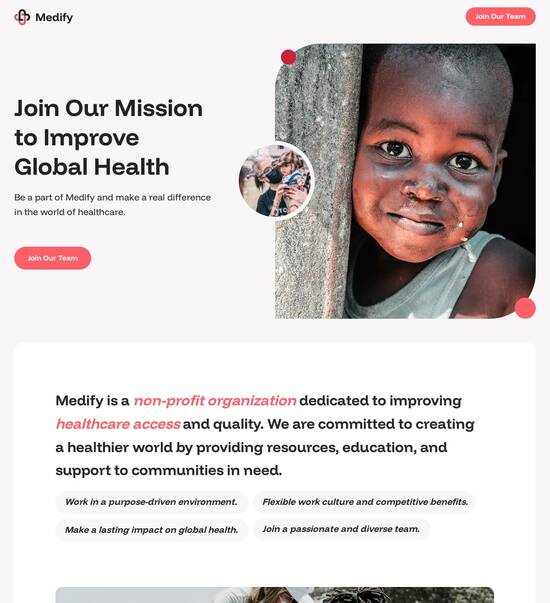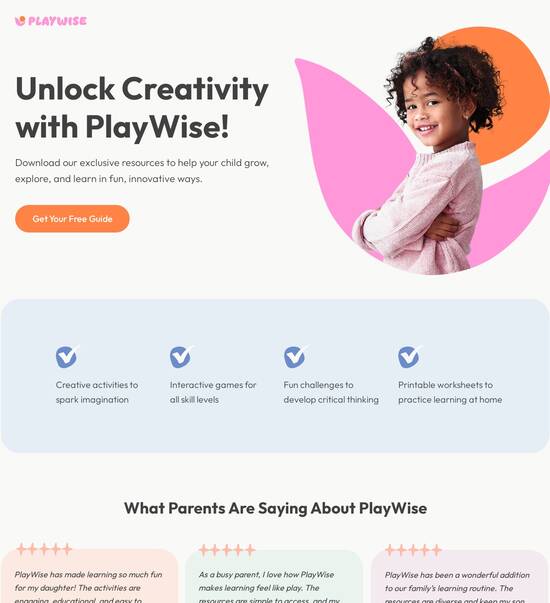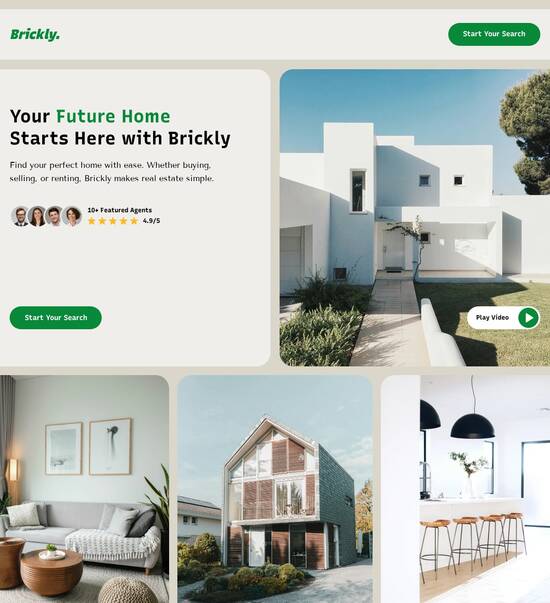
HTML page template for Prompt engineers
Use TemplateAbout template
Attract clients and showcase your skills with style using our landing page templates for Prompt engineers. Let's convert those visitors into clients!
Recommended templates

Easy to build without coding
With the intuitive drag-and-drop builder, anyone on your team can create high-converting pages without any knowledge of code or design. Make enhancements to your landing page with custom widgets using Javascript, HTML/CSS, or third-party scripts.

Multiple layouts for any industry and goal
Select from 500+ landing page layouts built to boost conversions across industry-specific scenarios. Customize them by adjusting fonts, adding images, and generating on-brand content with the AI assistant. Quickly scale with Instablocks® and Global Blocks that you can save, reuse, and update globally.

Loads fast and looks polished on any device
Every template is responsive, which means they present professionally on any device and load blazingly fast with our Thor Render Engine. You can also power them up with Google AMP technology to deliver an unparalleled mobile experience and drive higher conversions.

Robust analytics & experimentation
Get real-time updates and reporting across all your devices, showing the number of visitors, conversions, cost-per-visitor, and cost-per-lead. Launch AI-powered experiments, run A/B tests, and use heatmaps to analyze user behavior, then optimize your landing page to maximize conversions.







Easy to build without coding
With the intuitive drag-and-drop builder, anyone on your team can create high-converting pages without any knowledge of code or design. Make enhancements to your landing page with custom widgets using Javascript, HTML/CSS, or third-party scripts.
Multiple layouts for any industry and goal
Select from 500+ landing page layouts built to boost conversions across industry-specific scenarios. Customize them by adjusting fonts, adding images, and generating on-brand content with the AI assistant. Quickly scale with Instablocks® and Global Blocks that you can save, reuse, and update globally.
Loads fast and looks polished on any device
Every template is responsive, which means they present professionally on any device and load blazingly fast with our Thor Render Engine.
Robust analytics & experimentation
Get real-time updates and reporting across all your devices, showing the number of visitors, conversions, cost-per-visitor, and cost-per-lead. Launch AI-powered experiments, run A/B tests, and use heatmaps to analyze user behavior, then optimize your landing page to maximize conversions.
All the features you need to build ai promt hmtl template
Explore more featuresLearn how to build expertise showcase prompt
FAQs
Leading the way in building high-performing landing pages





Step-by-step guide for using Instapage for efficient landing page optimization
Instapage facilitates marketers in the USA by offering the most powerful landing page and conversion rate optimization (CRO) tools, designed to maximize ROI from digital campaigns. By leveraging the capabilities of Instapage, marketers in various sectors, such as education, financial services, and tech, can create high-converting landing pages that significantly improve their campaign results.
Understanding the benefits of Instapage
Instapage provides an all-in-one solution that combines ease of use with powerful features tailored for landing page creation and optimization. The platform offers access to extensive customization and personalization options, enabling the crafting of tailored messages that resonate with distinct audiences, ultimately increasing engagement and conversion rates.
- Access to over 100 high-converting templates: These templates are designed to cater to various marketing needs, ensuring you don't start from scratch.
- Built-in analytics and optimization tools: Instapage allows you to track page performance, conduct A/B tests, and harness heatmaps for better insights into user behavior.
- Collaboration features for teams: Work seamlessly with your team, offering real-time editing and feedback, which speeds up the review and production process.
Creating your first landing page
The first step in your journey with Instapage is to create your landing page. Here’s how to get started:
- Choose a template that fits your campaign objectives and brand ethos, allowing you to not reinvent the wheel.
- Utilize Instablocks for efficient design: These blocks can be customized and reused across different pages, enhancing consistency and speed.
- Add lead generation elements: Integrate forms, buttons, and call-to-action (CTA) components to engage visitors effectively.
Optimizing and personalizing your landing pages
Once your landing page is live, the next step is to continuously optimize and personalize the content:
- Implement A/B testing to compare two different versions of your page, determining which version converts better.
- Utilize dynamic text replacement to tailor experiences based on the visitor’s search queries or referring ads, thus improving relevance.
- Analyze user behavior with heatmaps and analytics to make data-driven adjustments that enhance user engagement.
Utilizing Instapage ensures consistent improvement in conversion rates, enabling campaigns to scale effortlessly.
In conclusion, with Instapage, marketers can easily create powerful landing pages that drive results. The combination of ready-to-use templates, robust analytics, and personalization capabilities positions it as the ideal platform for businesses across various sectors in the USA.
Start leveraging Instapage today to maximize the effectiveness of your digital marketing campaigns and transform your conversion rates!
People also ask about HTML page template for Prompt engineers
HTML page templates for prompt engineers
Understanding HTML page templates for prompt engineers
HTML page templates serve as the backbone for web applications, allowing prompt engineers to craft user experiences efficiently. These templates are predefined layouts and functionalities built using HTML, CSS, and potentially JavaScript. By defining HTML page templates, developers create a starting point that can be adapted and customized for various use cases in prompt engineering.
The primary purpose of these templates is to streamline the development process of interactive prompts. Instead of building each component from scratch, prompt engineers can leverage existing templates that cater to specific needs. Templates ensure that the core functionalities and designs are consistent, making it easier to scale projects while maintaining a coherent user experience.
Importance of templates in development
Efficiency plays a crucial role in modern web development. Using HTML page templates significantly reduces the time and effort required to launch new projects. Developers can quickly create prototypes and iterate based on testing or feedback, which ultimately leads to faster delivery of prompt solutions.
Another benefit of templates is the consistency they bring across different projects. Similar designs and code structures can be reused and modified, thus enhancing the overall quality and reliability of prompt engineering initiatives. By establishing a standard template, teams can ensure that all pages adhere to branding and functional standards, which is vital for maintaining user trust.
The unique capabilities of templating
The power of HTML templates lies in their advanced features, accommodating the needs of prompt engineers effectively. Comprehensive templating includes a structured layout that organizes content logically, making it straightforward for both development and end-user experience. In addition, built-in syntax facilitates the addition of scripts or styles that enhance the template's functionality, further enriching the user engagement.
Customization is one of the standout attributes of templating. By using variables, developers can insert dynamic content into their prompts, making the interaction more personalized. This capability not only heightens user engagement but also aligns the prompts with specific user behaviors and preferences, ensuring an overall tailored experience.
Reusable components for faster development cycles.
Pre-built scripts that simplify functionality.
Adaptable styles to match branding guidelines.
Specific types of templates for prompt engineering
When considering templates for prompt engineering, they can be categorized into various types based on usage. Standard templates serve general purposes and can be easily adapted for different scenarios. On the other hand, custom-engineered templates are built for specific applications, allowing prompt engineers to address unique requirements without implementing unnecessary bloat.
Furthermore, niche templates cater to specialized contexts within certain industries. For instance, templates designed for educational platforms may include features such as grading systems or session timers, while marketing-focused templates might prioritize lead generation forms and analytics integration. By developing templates specific to workflows, engineers can optimize user interactions efficiently.
Standard templates for common use cases.
Custom-engineered templates tailored to project needs.
Niche templates with unique functionalities.
Engineering templates for specific workflows
Designing templates with specific workflows in mind allows developers to enhance productivity. By understanding the processes that end users typically engage in, templates can be structured to facilitate those actions. For example, a template focused on data collection might have built-in validation steps to guide users, minimize errors, and improve submission reliability.
Case studies indicate that teams utilizing tailored templates see increased efficiency and effectiveness in their project outcomes. These specialized templates assist in automating certain tasks, enabling prompt engineers to focus on more complex challenges instead of repetitive coding.
The role of prompts in template design
To create effective HTML page templates, a clear understanding of prompt engineering is essential. At its core, prompt engineering involves designing input and output interactions that meet user expectations. Prompts should facilitate clarity, encouraging users to engage with the content seamlessly without confusion. Given their pivotal role, prompts significantly influence the overall user experience.
To craft prompts that resonate with users, it's important to align them closely with user needs. Tools for creating effective prompts include user research and usability testing results, which can guide the design process. This alignment ensures that prompts are not just functional but also engaging, providing users with the information they require while encouraging interaction.
Understand user intentions to create relevant prompts.
Use iterative testing to refine prompt clarity.
Implement user feedback to enhance prompt effectiveness.
Integration of services menu with templates
Integrating services menus into HTML page templates greatly enhances user experience. These menus allow users to navigate through various functionalities easily. They can be implemented in a way that is intuitive, ensuring that essential features are readily accessible, thereby reducing friction in user interactions.
In modern web design, ensuring robust integration of services is essential. This cohesion not only helps in maintaining brand consistency but also optimizes the overall usability of the application. Effective integration patterns allow for a more fluid interaction, ultimately driving engagement and satisfaction.
Create intuitive navigation paths with services menus.
Enhance functionality through seamless integration.
Ensure consistency in design and user experience.
API integration for template enhancements
Leveraging APIs is a powerful way to enhance the capabilities of HTML page templates. By integrating external services, developers can provide additional functionalities, such as data processing, real-time updates, or enhanced analytical insights. This level of integration allows templates not only to serve basic functions but also to adapt to users’ needs in complex ways.
Real-world applications of API integrations in templates are extensive. For instance, integrating with CRM services can help capture user interactions directly, improving lead tracking and follow-up processes. By employing these integrations, prompt engineers can transform basic templates into comprehensive tools that yield significant returns on investment.
Advanced filtering and customization techniques
Implementing advanced filtering techniques in HTML templates provides a greater level of personalization and relevance to users. Filters allow users to sift through information based on specific criteria, making the experience more engaging and tailored to their preferences. For example, a template may offer filtering options for products based on categories, price, or features, leading to higher user satisfaction.
Common applications of filtering within templates include e-commerce sites, where users expect to navigate through extensive product lists efficiently. By providing users with control over what they see, the probability of a purchase significantly increases, showcasing the value of implementing filtration systems.
Enhance user experience with robust filtering options.
Provide relevant content based on user selection.
Increase engagement through personalized interactions.
Customization options for developers
Customization options available for developers empower them to modify templates according to specific project needs. Tools and frameworks often come with flexible settings, enabling easy adjustments for both aesthetics and functionality. This adaptability ensures developers can create unique experiences while still relying on foundational aspects of the templates.
Creative implementations of customization lead to standout user experiences. Developers can integrate unique elements such as animations, transitions, or interactive features that align with a brand’s voice. This not only enhances engagement but also solidifies brand identity in an increasingly competitive landscape.
Best practices for development workflows
To streamline development processes when utilizing HTML page templates, it’s essential to have a clear checklist in place. This checklist should include defining project scope, determining template requirements, and ensuring compatibility with existing systems. Having a structured process aids in effectively deploying templates without unnecessary complications.
Collaboration among developers is crucial in maintaining productivity. Utilizing shared templates allows for consistency across projects, while version control can mitigate conflicts when multiple team members work on the same components. Establishing a collaborative pipeline ensures that project success is accessible to all stakeholders.
Create a development checklist for template implementation.
Use version control systems for team collaboration.
Facilitate regular meetings to align project goals.
Evaluating the impact of template engineering
Measuring the success of engineering templates involves identifying key performance indicators (KPIs) that reflect user engagement, conversion rates, and overall satisfaction. By setting benchmarks, prompt engineers can analyze how well the templates serve their intended purpose and make necessary adjustments based on quantitative data.
User feedback is another essential component for iterative improvements. Collecting insights about user experiences with prompts can expose areas needing refinement, thus allowing for the continuous evolution of templates to meet user needs effectively. This cyclical approach ensures templates remain relevant in an ever-changing technological landscape.
Determine KPIs to measure template performance.
Incorporate user feedback for continual improvement.
Adapt templates based on insights and trends.
Long-term trends in prompt engineering
The evolution of templating capabilities reflects broader trends in web development and user expectations. The ongoing shifts towards personalization and interactivity necessitate that HTML templates offer innovative features. These capabilities enhance user experiences and evolve with advancements in technology.
Looking ahead, the focus will likely shift towards even more adaptive templates that can learn from user behavior and adjust accordingly. This enables a more responsive environment, aligning the prompts closer to individual needs and creating a more engaging interaction overall.
Real-world applications and examples
Diverse industries are leveraging HTML templates to enhance their prompt engineering efforts. Case studies demonstrate successful implementations across various fields, from e-commerce platforms optimizing user flows to educational institutions creating interactive learning modules.
Through these examples, teams can learn valuable lessons, particularly the importance of aligning templates with specific audience requirements. By deriving insights from both successes and challenges, prompt engineers can fine-tune their strategies for future projects.
E-commerce businesses utilizing templates for product showcases.
Educational platforms enhancing user engagement through learning modules.
Health sector applications for patient interaction via templated forms.
Interviews with prompt engineering professionals
Insights from seasoned prompt engineering professionals reveal that successful projects stem from a solid understanding of user requirements and effective use of templates. Their experiences highlight the necessity of flexibility in design, allowing for adjustments based on iterative feedback.
Additionally, many professionals emphasize the value of collaboration among team members. Sharing templates and insights fosters creativity and innovation, paving the way for superior outcomes in prompt engineering initiatives.
Conclusion: The transformative nature of HTML page templates
In summary, HTML page templates stand as transformative tools for prompt engineers, enhancing the efficiency and effectiveness of their projects. From ensuring consistent designs to facilitating rapid development cycles, the advantages offered by templates cannot be overstated.
The future of prompt engineering and templating is ripe with opportunity for exploration and innovation. As technology evolves, so too will the possibilities within HTML templating. With a mindset of continuous learning and experimentation, prompt engineers can harness these changes to craft even more engaging and user-centered experiences.
Templates enhance development speed and efficiency.
Customization options allow unique user engagements.
Integration capabilities open doors to robust functionalities.
Ready to skyrocket conversions?
Supercharge your ad campaigns with high-performing landing pages
Get started














